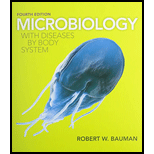
Microbiology with Diseases by Body System & Modified MasteringMicrobiology with Pearson eText -- ValuePack Access Card -- for Microbiology with Diseases by Body System Package
1st Edition
ISBN: 9780133857122
Author: Robert W. Bauman Ph.D.
Publisher: PEARSON
expand_more
expand_more
format_list_bulleted
Concept explainers
Question
Chapter 17, Problem 2MTF
Summary Introduction
Introduction:
Immunization is a process that makes a person immune against infection. A biological preparation that offers immunity against a particular disease is termed as a vaccine. There are different types of vaccines available. They are attenuated vaccines, killed vaccines, toxoid vaccines, and combined vaccines.
Expert Solution & Answer
Want to see the full answer?
Check out a sample textbook solution
Students have asked these similar questions
What is the structure and function of Eukaryotic cells, including their organelles? How are Eukaryotic cells different than Prokaryotic cells, in terms of evolution which form of the cell might have came first? How do Eukaryotic cells become malignant (cancerous)?
What are the roles of DNA and proteins inside of the cell? What are the building blocks or molecular components of the DNA and proteins? How are proteins produced within the cell? What connection is there between DNA, proteins, and the cell cycle? What is the relationship between DNA, proteins, and Cancer?
Why cells go through various types of cell division and how eukaryotic cells control cell growth through the cell cycle control system?
Chapter 17 Solutions
Microbiology with Diseases by Body System & Modified MasteringMicrobiology with Pearson eText -- ValuePack Access Card -- for Microbiology with Diseases by Body System Package
Ch. 17 - Prob. 1TMWCh. 17 - A diagnostician used an ELISA to show that a...Ch. 17 - To obtain immediate immunity against tetanus, a...Ch. 17 - Which of the following vaccine types is commonly...Ch. 17 - Prob. 3MCCh. 17 - When antigen and antibodies combine, maximal...Ch. 17 - An anti-antibody is used when _________. a. an...Ch. 17 - Prob. 6MCCh. 17 - Prob. 7MCCh. 17 - Prob. 8MC
Ch. 17 - Prob. 9MCCh. 17 - Prob. 10MCCh. 17 - Prob. 11MCCh. 17 - An antiserum is ________. a. an anti-antibody b....Ch. 17 - Prob. 13MCCh. 17 - Prob. 14MCCh. 17 - Prob. 15MCCh. 17 - Prob. 1MTFCh. 17 - Prob. 2MTFCh. 17 - Prob. 3MTFCh. 17 - Modified True/False 4. _________________ ELISA is...Ch. 17 - Prob. 5MTFCh. 17 - Match the characteristic in the first column with...Ch. 17 - Identify the chemicals represented by this artists...Ch. 17 - Prob. 2VICh. 17 - Compare and contrast the Chinese practice of...Ch. 17 - What are the advantages and disadvantages of...Ch. 17 - Compare the advantages and disadvantages of...Ch. 17 - How does precipitation differ from agglutination?Ch. 17 - Explain how a pregnancy test works at the...Ch. 17 - Compare and contrast herd immunity and contact...Ch. 17 - How does nephelometry differ from turbidimetry?Ch. 17 - Is it ethical to approve the use of a vaccine that...Ch. 17 - Which is worse: to use a diagnostic test for HIV...Ch. 17 - Discuss the importance of costs and technical...Ch. 17 - What bodily fluids, in addition to blood serum,...Ch. 17 - Why might a serological test give a false positive...Ch. 17 - Some researchers want to distinguish B cells from...Ch. 17 - Describe three ways by which genetic recombinant...Ch. 17 - How does a toxoid vaccine differ from an...Ch. 17 - Explain why many health organizations promote...Ch. 17 - Contrast a hemagglutination test with a viral...Ch. 17 - Prob. 11CTCh. 17 - Draw a picture showing, at both the molecular and...Ch. 17 - Prob. 1CM
Knowledge Booster
Learn more about
Need a deep-dive on the concept behind this application? Look no further. Learn more about this topic, biology and related others by exploring similar questions and additional content below.Similar questions
- In one paragraph show how atoms and they're structure are related to the structure of dna and proteins. Talk about what atoms are. what they're made of, why chemical bonding is important to DNA?arrow_forwardWhat are the structure and properties of atoms and chemical bonds (especially how they relate to DNA and proteins).arrow_forwardThe Sentinel Cell: Nature’s Answer to Cancer?arrow_forward
- Molecular Biology Question You are working to characterize a novel protein in mice. Analysis shows that high levels of the primary transcript that codes for this protein are found in tissue from the brain, muscle, liver, and pancreas. However, an antibody that recognizes the C-terminal portion of the protein indicates that the protein is present in brain, muscle, and liver, but not in the pancreas. What is the most likely explanation for this result?arrow_forwardMolecular Biology Explain/discuss how “slow stop” and “quick/fast stop” mutants wereused to identify different protein involved in DNA replication in E. coli.arrow_forwardMolecular Biology Question A gene that codes for a protein was removed from a eukaryotic cell and inserted into a prokaryotic cell. Although the gene was successfully transcribed and translated, it produced a different protein than it produced in the eukaryotic cell. What is the most likely explanation?arrow_forward
- Molecular Biology LIST three characteristics of origins of replicationarrow_forwardMolecular Biology Question Please help. Thank you For E coli DNA polymerase III, give the structure and function of the b-clamp sub-complex. Describe how the structure of this sub-complex is important for it’s function.arrow_forwardMolecular Biology LIST three characteristics of DNA Polymerasesarrow_forward
arrow_back_ios
SEE MORE QUESTIONS
arrow_forward_ios
Recommended textbooks for you
- Essentials of Pharmacology for Health ProfessionsNursingISBN:9781305441620Author:WOODROWPublisher:Cengage
 Anatomy & PhysiologyBiologyISBN:9781938168130Author:Kelly A. Young, James A. Wise, Peter DeSaix, Dean H. Kruse, Brandon Poe, Eddie Johnson, Jody E. Johnson, Oksana Korol, J. Gordon Betts, Mark WomblePublisher:OpenStax College
Anatomy & PhysiologyBiologyISBN:9781938168130Author:Kelly A. Young, James A. Wise, Peter DeSaix, Dean H. Kruse, Brandon Poe, Eddie Johnson, Jody E. Johnson, Oksana Korol, J. Gordon Betts, Mark WomblePublisher:OpenStax College





Essentials of Pharmacology for Health Professions
Nursing
ISBN:9781305441620
Author:WOODROW
Publisher:Cengage

Anatomy & Physiology
Biology
ISBN:9781938168130
Author:Kelly A. Young, James A. Wise, Peter DeSaix, Dean H. Kruse, Brandon Poe, Eddie Johnson, Jody E. Johnson, Oksana Korol, J. Gordon Betts, Mark Womble
Publisher:OpenStax College